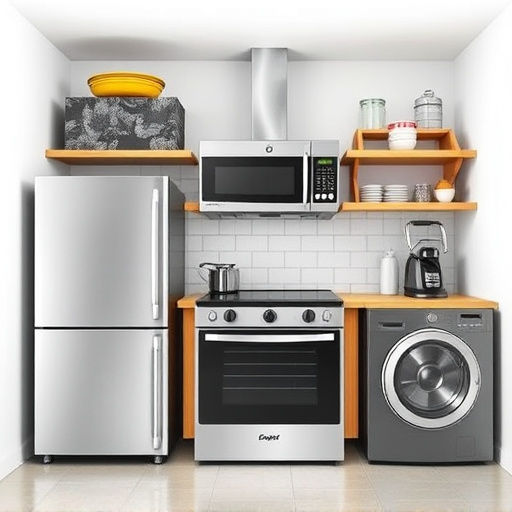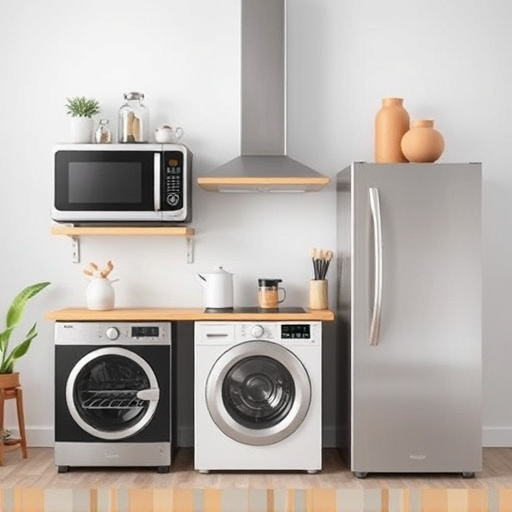Washing machines produce vibration noise due to drum rotation and water/cloth movement. Shock absorbers (vibration dampeners) mitigate these issues, reducing noise and vibrations for smoother operation. Essential in major appliances like washing machines, they enhance user experience in close-knit living spaces by minimizing noise transfer. Regular maintenance, including inspection and cleaning, is crucial to keep shock absorbers in top condition, ensuring optimal performance and noise reduction.
Tired of loud, vibrating washing machines that disrupt your home’s tranquility? The solution lies in the unsung heroes—shock absorbers. This article explores how these essential components, crucial in major appliances, tackle vibration noise. We’ll delve into the science behind it, from understanding the causes of disruptive noises to the specific role shock absorbers play. Learn about their benefits for home comfort and discover the different types used, plus maintenance tips to ensure your machine runs smoothly and quietly.
- Understanding Vibration Noise in Washing Machines
- The Role of Shock Absorbers in Major Appliances
- How Shock Absorbers Minimize Noise Transfer
- Benefits of Reduced Vibration for Home Comfort
- Types of Shock Absorbers Used in Washing Machines
- Maintaining and Replacing Washing Machine Shock Absorbers
Understanding Vibration Noise in Washing Machines

Washing machines, despite their convenience, can sometimes be noisy appliances. One of the most common issues is vibration noise, which occurs due to the machine’s spinning motion and the interaction between its internal components. This noise can range from a subtle hum to a loud thumping, depending on various factors. The primary source of vibration is the drum, which rotates at high speeds during the wash cycle. As water and clothes move around inside, they create a dynamic environment that can lead to excessive vibrations.
In major appliances like washing machines, vibration noise is not only annoying but can also indicate potential issues. Over time, improper installation, worn-out parts, or misalignment can contribute to increased vibrations. Shock absorbers, also known as vibration dampeners, are designed to mitigate these unwanted vibrations and reduce noise levels. By absorbing the energy generated during operation, they ensure a smoother and quieter performance, enhancing the overall user experience with such essential household items.
The Role of Shock Absorbers in Major Appliances

In the realm of major appliances, shock absorbers play a pivotal role in ensuring smooth operation and comfort. These specialized components are designed to mitigate vibrations, especially during high-speed operations like washing or drying clothes. By absorbing and dispersing energy, shock absorbers significantly reduce noise levels, making these appliances more efficient and user-friendly.
In washing machines, for instance, shock absorbers prevent the machine from transferring intense vibrations to the floor or surface it’s mounted on. This is particularly important in urban settings where noise pollution is a concern. Through advanced materials and designs, modern shock absorbers enhance the overall experience of using major appliances, aligning with the growing demand for quieter, more harmonious living spaces.
How Shock Absorbers Minimize Noise Transfer

Shock absorbers in major appliances like washing machines play a vital role in minimizing noise transfer, significantly enhancing the overall user experience. These absorbers are designed to absorb and dissipate energy that would otherwise be transmitted as unwanted vibrations and noise. When the washing machine operates, various components interact with each other, creating motions and forces that can lead to loud noises if not properly managed.
The shock absorbers act as a buffer between these moving parts, dampening the vibrations at their source. By reducing the intensity of these vibrations, they prevent them from resonating through the machine’s body and into the surrounding environment. This is particularly important in close-knit living spaces where noise levels can quickly become disruptive. The strategic placement of shock absorbers ensures a smoother, quieter operation, making domestic tasks more comfortable and peaceful.
Benefits of Reduced Vibration for Home Comfort

Reduced vibration in households, thanks to washing machine shock absorbers, offers a multitude of benefits that extend beyond mere noise reduction. A quieter home environment means residents can enjoy peace and tranquility, especially during off-peak hours or when sleeping. This is particularly advantageous for apartment dwellers or those living in close quarters, where the transmission of noises can disrupt daily routines.
Furthermore, minimizing vibration contributes to overall home comfort. It prevents tiresome resonance that can lead to a sense of unease or even physical discomfort. For individuals with sensitivity to noise or motion, washing machine shock absorbers can make a significant difference in creating a calm and relaxing living space. By prioritizing these features, major appliances like washing machines become not just functional tools but integral parts of fostering a comfortable home environment.
Types of Shock Absorbers Used in Washing Machines

Washing machines, being a common fixture in most households, often come equipped with shock absorbers designed to mitigate noise and vibrations during operation. These shock absorbers are crucial components that play a vital role in ensuring a smooth and quiet wash cycle. In the context of major appliances, understanding the types of shock absorbers used is essential for consumers looking to reduce unwanted noises in their laundry rooms.
There are primarily two types of shock absorbers commonly found in modern washing machines: rubber feet and metal springs. Rubber feet act as a buffer between the machine’s base and the floor, absorbing a significant portion of the generated vibrations. Metal springs, on the other hand, work by compressing and releasing energy, effectively dampening high-frequency noises. Many advanced models employ a combination of these technologies to offer optimal noise reduction, making laundry time quieter for everyone in the household.
Maintaining and Replacing Washing Machine Shock Absorbers

Regular maintenance is key to keeping your washing machine’s shock absorbers in top condition, ensuring they continue to reduce vibration noise effectively. Over time, these components can become worn or damaged, especially if your machine is heavily used or exposed to frequent power surges. Inspecting and cleaning the shock absorbers periodically can prevent buildup of lint, dirt, or other debris that might hinder their performance.
Replacing washing machine shock absorbers should be considered when they show significant signs of wear or failure. Many major appliance manufacturers recommend periodic replacement for optimal performance and noise reduction. Having spare parts on hand makes this task straightforward; simply unscrew the old absorbers and install the new ones, following your machine’s user manual for specific instructions. This quick maintenance step can significantly improve your laundry experience by minimizing excessive vibration and associated noise levels.
Washing machine shock absorbers play a crucial role in minimizing vibration noise, significantly enhancing home comfort. By absorbing excess energy, these components ensure that your laundry cycles are quieter and smoother, contributing to a more peaceful living environment. In the context of major appliances, shock absorbers are essential for maintaining a balance between performance and operational tranquility. Regular maintenance and timely replacement ensure these absorbers continue to deliver optimal results, making your washing machine a reliable and quiet companion in the heart of your home.
